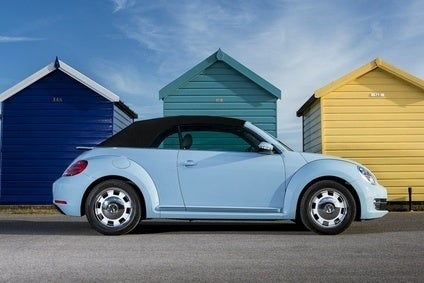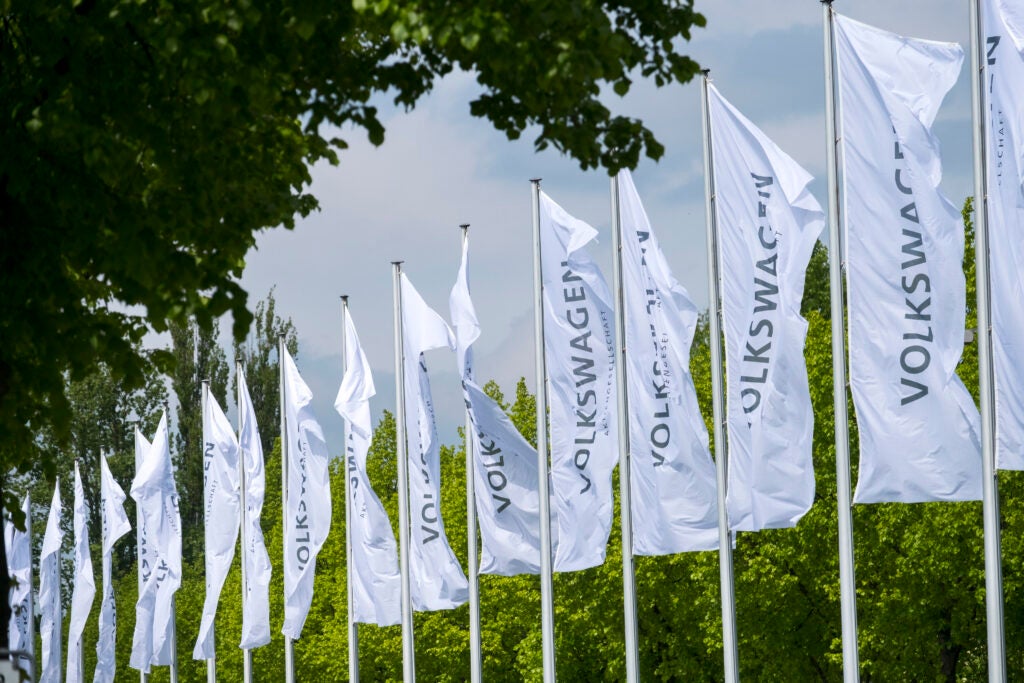
The global market for convertibles might be in decline but there's still good business to be had in the UK. The out of production Eos hasn't been replaced and the facelifted Golf Cabrio won't be in showrooms until February, so the Beetle Cabrio now has its chance to shine.
It’s a little hard to believe that the current Beetle is now more than four years old. Until recently, not a lot has happened in terms of updates, but the enforcement of Euro 6 emissions laws from 1 September mean some tweaked engines are now on sale.
Let’s step back to 2011 for a moment, though. Build of this replacement for the New Beetle commenced in July of that year, and all cars are manufactured at Puebla by Volkswagen de México. According to the company, more than 50 of its suppliers are located in a 50 km radius. Twenty of the most important Tier 1s have their own facilities in industrial parks next to the plant, making JiT deliveries easier.
Unlike the current Golf, this model uses the older PQ35 architecture, so think of VW324 (hatchback) and VW325 (Cabriolet) as being based on the same platform as the Mark VI Golf.
This car has a few different names. In most of the world, it’s Beetle, but in Germany it’s The Beetle; in Brazil, it’s Fusca; in Italy, Maggiolino; and Coccinelle in France.
There is one more name on the way, denoting a third bodystyle. The Dune, a crossover variant, will be launched in early 2016, Volkswagen of America announced at the New York auto show in April 2015. This was previewed by the Beetle Dune, a concept which premiered at the Detroit auto show in January 2014.
How well do you really know your competitors?
Access the most comprehensive Company Profiles on the market, powered by GlobalData. Save hours of research. Gain competitive edge.

Thank you!
Your download email will arrive shortly
Not ready to buy yet? Download a free sample
We are confident about the unique quality of our Company Profiles. However, we want you to make the most beneficial decision for your business, so we offer a free sample that you can download by submitting the below form
By GlobalDataThe standard engine in the car's largest market, the US, was originally a 170hp 2.5-litre five-cylinder petrol, with a 200hp 2.0-litre four-cylinder turbo optional, or instead, a 2.0-litre TDI. The petrol-electric powertrain from the Jetta Hybrid had at one stage been planned to be added but this now seems unlikely given what’s been happening to fuel prices, and how OEMs’ marketing departments and most potential buyers think of hybrids as fuel savers.
An e-Bugster concept had its global debut at the Detroit auto show in January 2012. This was a plug-in version of the Beetle powered by an 85kWh motor, in combination with a 28.3kWh lithium-ion battery pack. This design study was said to be 90mm lower than the Beetle, thanks to a new roof, whilst also being 30mm wider. This was followed up by a convertible version of the e-Bugster at the Beijing motor show in April 2012. Since then…nothing, sadly. But we shouldn't’t give up on the possibility of a production model just yet.
Volkswagen appears to have learned the lesson of the New Beetle, which, apart from a variety of additional engines, was pretty much left alone throughout what became a long lifecycle. As BMW has shown with Mini, constantly rolling out new variants is key to turning a niche model into a handily high-margin, big selling one.
In Europe, all engines for the Beetle have forced induction and the range includes 1.6- and 2.0-litre diesels as well as 1.2-, 1.4- and 2.0-litre petrol units. The five-cylinder petrol unit was never available here. All units can be ordered in either hatchback or convertible forms.
The open-topped car’s global debut was at the Los Angeles auto show in late November 2012 and the 2013 model year was its first in North America. For the region’s 2014 model year, the 2.5-litre five-cylinder petrol engine was replaced by a more economical 1.8-litre four-cylinder turbocharged unit. It produces the same 170hp but there is slightly more torque. This EA888 series engine is built at VW's Silao plant in Mexico.
A new 150hp 2.0-litre TDI was introduced by Volkswagen of America for the 2015 model year and the Beetle was one of the first models to be equipped with it. As for the 2016MY Beetle, there were only minor changes, these having been recently announced by Volkswagen of America.
In Britain, sales are OK rather than brisk and you could never call this a core model in any of the VW brand’s European’s markets. The car’s age is now starting to play against it, as US sales show too. There, registrations for the year to date are down by 18% to a combined 17,527 units of the ‘Coupe’ and Convertible. The numbers for August fell by 26% and 28% respectively. The Dune and a mid-life refresh for the hatchback and cabrio due in 2016 should mean a timely boost.
Volkswagen of course has bigger fish to fry than the mid-life fade away of a relatively small volume model. China is a huge concern, given the percentage of the brand’s global passenger car sales which take place there. And yet, as last week’s leader in The Economist points out, even 5% growth this year, the low end of reasonable estimates, would add more to world output than the 14% expansion China posted in 2007. Add in the group’s hegemony in not just China but the European market, and things are not as dark for the German giant as some would have us believe.
Let’s get back to the Beetle though. It’s a perfect example of all that Volkswagen AG's vehicles do so much better than other brands. The perception of high quality is everywhere. Place a hand or finger on any component – steering wheel, gear lever, door handle, sliding seats to access the rear compartment, indicator stalks – and it’s well weighted and nice to the touch. You find consistent fonts on all gauges and buttons, the SatNav has the perfect mashup of plastic switches and touch-screen functions, while roof-down, the new Euro 6 1.2 petrol turbo engine sounds just sporty enough but never noisy. Shame about the seven-speed DSG which is fine but not as smooth at low speeds as a torque converter automatic.
Compared to the New Beetle, the Beetle has a lot more room for the two occupants in the back, and that includes times when the roof is in place. This goes up and down in 10 seconds almost silently at the touch of a button – no handles to pull or even window switches to hold up or down as they sync with the top’s movements. You can also raise or lower it on the move, provided the speed is under 30mph. Should you want to use it, there’s also a tonneau to cover the folded roof.
At 225 litres the boot is 24 litres larger than that in the previous model, while the rear seat bench can also be folded (see pics). The windscreen was moved rearwards compared to the New Beetle, which meant 12mm more headroom in the back seats thanks to the altered shape of the roof.
As well as pop-up rollover bars made from high tensile strength steel and aluminium, other specific modifications include a stable tubular member in the top edge of the door, reinforced A-pillars (additional 0.5 mm sheet metal thickness) and particularly strong rocker panels. In side-on collisions, the function of the most important structural components are assumed by the reinforced B-pillars, the floor cross-members and the doors. The entire reinforcement and the rollover protection system result in 114kg of additional weight for the convertible in comparison to the hatchback.
One other detail: the resonant torsional frequency has a value of 17.8 Hz, making this one convertible that does not require any vibration dampers. This is obvious from the driver’s seat as you won’t notice a fuzzy view in the rear-vision mirror. Nor does opening or closing a door when parked at an angle and sideways on a slope result in any nasty sounding clangs.
Future convertibles
Volkswagen still offers the Eos in the US but production ended a few months ago. The Golf Cabrio, meanwhile, continues to be made and sells fairly well, in Britain especially. But when such cars are not popular in China and unavailable in India due to a lack of demand, can VW justify developing replacements?
There had been rumours suggesting that the Beetle would not have a successor but in April 2015, Volkswagen told the media that it would be, "within three years”. The next model will use an evolution of the MQB A/B architecture, as will so many compact vehicles in the Volkswagen Group’s brands’ future line-up.
The Golf Cabrio is safe for now, a mid-cycle update being soon to appear – at the Frankfurt IAA in fact – and that should see it through to 2018. As the current car isn’t offered in North America, the smart money seems to be backing the Beetle becoming VW’s only global convertible. Would profits suffer? Not necessarily; in fact they will probably rise, though they will be coming from a different Group brand. The A3 and S3 Cabrios have been successful for Audi, as have the A5, S5 and RS 5, with replacements for the larger three all due in under a year’s time. For Volkswagen, as the addition of the Dune should show, the key to making good money out of niche models is to keep developing them.






